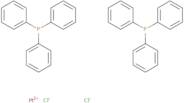cis-Dichlorobis(triphenylphosphine)platinum(II)
CAS: 15604-36-1
Ref. 3D-QAA60436
| 5g | Discontinued | ||
| 10g | Discontinued | ||
| 25g | Discontinued |
Product Information
- Bis(triphenylphosphine)dichloropalladium(II)
- Dichlorobis(triphenylphosphine)palladium(II)
- Bis(triphenylphosphine)palladium(II) dichloride
- Palladium(2+) Chloride-Triphenylphosphane (1:2:2)
- Phosphine, Triphenyl-, Palladium(2+) Salt, Dihydrochloride
- trans-Bis(triphenylphosphine)palladium dichloride
- Dichlorobis(Triphenylphosphine)Palladate (Ii)
- Cis-Bis(Triphenylphosphine)Platinum(Ii) Dichloride
- Dichlorobis(triphenylphosphine)platinum (II)
- cis-Bis(triphenylphosphine)platinum(II) chloride
- See more synonyms
- Trans-Dichlorobis(triphenyl-phosphine) Palladium(II)
- Bis(triphenylphosphine)palladium(II)chloride
cis-Dichlorobis(triphenylphosphine)platinum(II) is a chemical compound that contains a platinum atom. It reacts with anions, such as chloride, to form the corresponding cations. cis-Dichlorobis(triphenylphosphine)platinum(II) has been shown to have an antiproliferative effect on cancer cells in vitro and in vivo. This compound has also been shown to have a photoelectron spectroscopy and microscopy profile similar to that of platinum metal ions, which may be due to its ability to bind metal ions. cis-Dichlorobis(triphenylphosphine)platinum(II) can be prepared by reacting diethyl ester with palladium complexes in nonpolar solvents. The compound has been found to undergo hydrolysis in the presence of water and anions, yielding dichloroethane and triphenylphosphine





